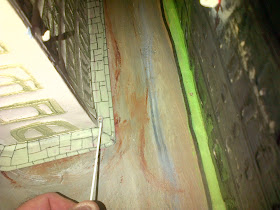The orange rods are brass and will carry 12 volts to the centrally located lamps. There are also 2 vertical brass rods which will go down through the baseboard to connect with the power supply.
In the diagram, the vertical rods are placed diagonally across from each other, but when I was drilling the holes for them today, I realised that it was more sensible to have the two rods directly across the street from one another other so that when they protruded under the baseboard they would be closer together to simplify connection to the 2-core cable that I would be soldering them onto. - if you follow my logic.
 |
| First hole. |
 |
| Second hole. |
The lattice resting on the 8 FIMO rosettes.
I'll paint the white cross-members and the rosettes - probably black.
*********************************************************************************
Currently listening to:
"An Unexpected Groovy Treat" by Finitribe.
I came across this outstanding 1992 recording this afternoon when I was sorting out my CD/Vinyl/cassettes cupboard. I presume the group have long since disbanded. They originated in Edinburgh.
~~~~~~~~~~~~~~~~~~~~~~~~~~~~~~~~~~~~~~~~~~~~~~~~~~~~~~~~~~~~~~~~~~~~~~~~
Last night's dinner:
Completely ridiculously, third night running eating a curry. This time a Chicken Korma from the supermarket plus 3 small tomatoes.
Today's lunch:
 |
| 2 boiled eggs, tomatoes and gherkins. |
Currently reading:
Read a whole bunch of pages in order to get the flow of Ryle's ideas and, in particular, exactly what he means by The Ghost in the Machine.
Then I'll return to where I was and revert to reading and taking notes one paragraph at a time. He's a damn fine prose writer.
MMMMMMMMMMMMMMMMMMMMMMMMMMMMMMMMMMMMMMMMMMMMMM
Miscellany:
 |
| Finitribe |
 |
| Gilbert Ryle |










































